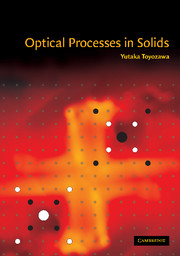Book contents
- Frontmatter
- Contents
- Preface
- Acknowledgments
- List of principal symbols
- 1 Radiation field
- 2 Quantum mechanics
- 3 Interaction of radiation with matter
- 4 Electronic vs. nuclear motions and the optical spectra of localized electrons in solids
- 5 Lattice vibrations
- 6 Electric susceptibility and dielectric constant
- 7 One-electron states in solids
- 8 Excitons
- 9 Polaron and the self-trapped state
- 10 Optical spectra of exciton in the phonon field Overview
- 11 Higher-order optical processes
- 12 Inner-shell excitation
- 13 Photo-induced structural changes
- 14 Light, matter and life (A scenario for the origin of life and its evolution)
- Appendix 1 Derivation of exciton Hamiltonian from many-body Hamiltonian
- Appendix 2 Transient spectra for second-order optical processes
- References (by chapter)
- Subject index
14 - Light, matter and life (A scenario for the origin of life and its evolution)
Published online by Cambridge University Press: 10 December 2009
- Frontmatter
- Contents
- Preface
- Acknowledgments
- List of principal symbols
- 1 Radiation field
- 2 Quantum mechanics
- 3 Interaction of radiation with matter
- 4 Electronic vs. nuclear motions and the optical spectra of localized electrons in solids
- 5 Lattice vibrations
- 6 Electric susceptibility and dielectric constant
- 7 One-electron states in solids
- 8 Excitons
- 9 Polaron and the self-trapped state
- 10 Optical spectra of exciton in the phonon field Overview
- 11 Higher-order optical processes
- 12 Inner-shell excitation
- 13 Photo-induced structural changes
- 14 Light, matter and life (A scenario for the origin of life and its evolution)
- Appendix 1 Derivation of exciton Hamiltonian from many-body Hamiltonian
- Appendix 2 Transient spectra for second-order optical processes
- References (by chapter)
- Subject index
Summary
Introduction
This chapter is of a different nature from the preceding chapters where more or less well-established principles of the spectroscopic studies of microscopic motions in condensed matter have been described, as is usual in texbooks and monographs. In this last chapter, however, the author is going to present his personal viewpoint on the role of solar radiation in creating life out of matter, sustaining living activities and driving the evolution of the living world – topics which have generally been considered to be beyond the scope of the physical sciences.
Obviously, life science is a vast interdisciplinary regime: the elucidation of life will need the cooperation of all areas of natural science. The majority of scientists working in any discipline will supposedly have a serious interest in the problem of life even when they do not mention that explicitly. The particular reason why the present author feels it necessary and useful to make remarks on this problem is that the various photochemical processes described in the preceding few chapters and the behaviors of charged particles in dielectrics described in other chapters have something to do with, and to shed light on, the role of solar radiation as an energy source and the role of water as a catalyst in living activities. Further investigation of these roles might contribute to constructing a bridge from our small corner of physical science, among many other such bridges under construction from different areas of science, towards elucidating the physical origin and evolution of life itself.
What the author can do as a theoretical physicist is present speculations based on the various empirical and experimental facts available.
- Type
- Chapter
- Information
- Optical Processes in Solids , pp. 371 - 390Publisher: Cambridge University PressPrint publication year: 2003



